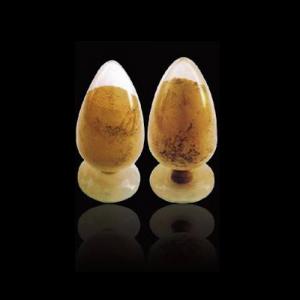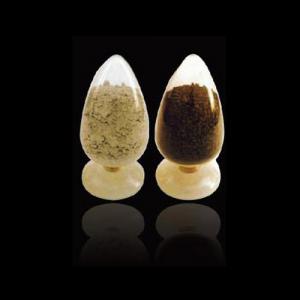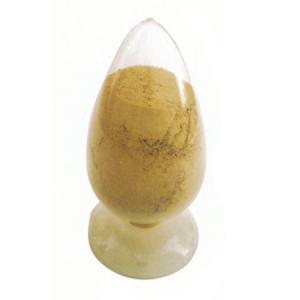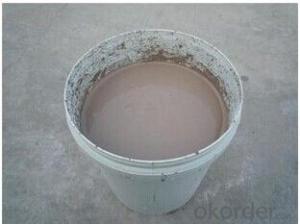High Alumina Based Mortar for Hot Blast Stove
- Loading Port:
- China Main Port
- Payment Terms:
- TT or L/C
- Min Order Qty:
- 2 m.t.
- Supply Capability:
- 5000 Tons Per Month m.t./month
OKorder Service Pledge
OKorder Financial Service
You Might Also Like
General Information of High Alumina Based Mortar for Hot Blast Stove
FIREF high alumina mortar for hot blast stove made as per international standards, is known for its low thermal conductivity, high refractoriness, and excellent thermal shock resistance.
Technical data of High Alumina Based Mortar for Hot Blast Stove
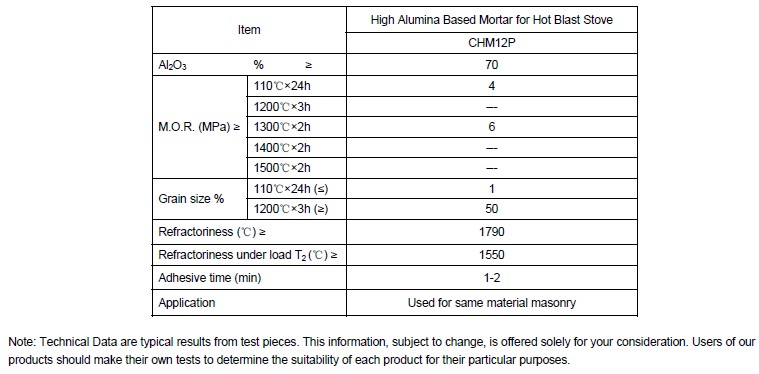
Production line and packing of High Alumina Based Mortar for Hot Blast Stove
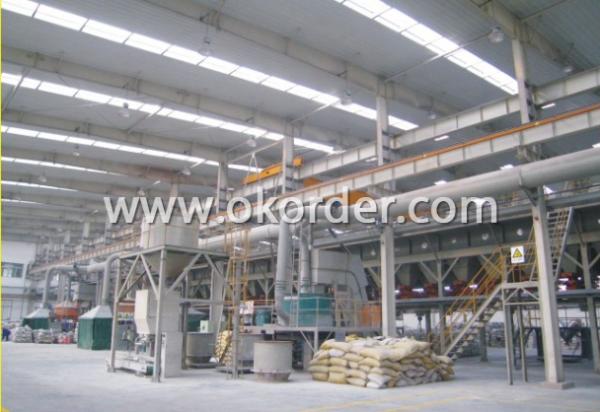
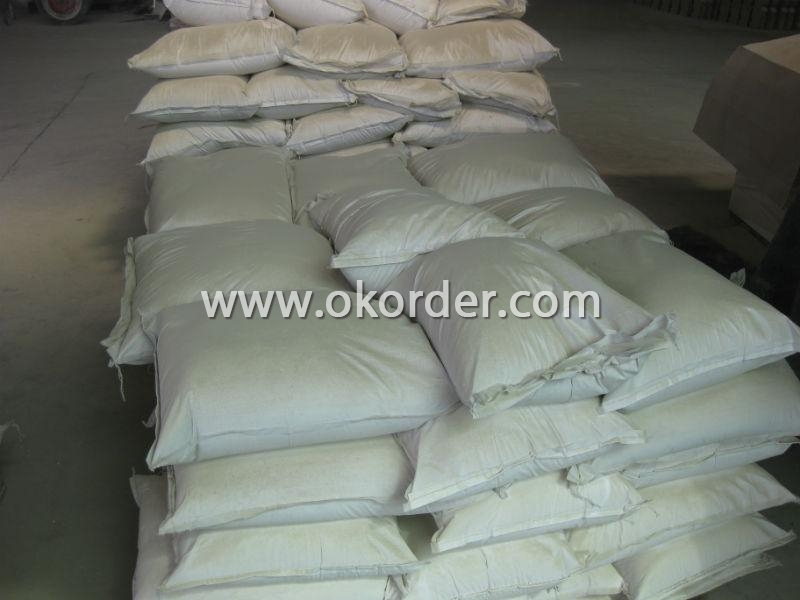
Feature of High Alumina Based Mortar for Hot Blast Stove
High refractoriness
Low thermal conductivity
Excellent mechanical strength
Excellent thermal shock resistance
Application of High Alumina Based Mortar for Hot Blast Stove
FIREF high alumina mortar for hot blast stove can be used with the refractory brics of the alike material.
- Q:How do monolithic refractories withstand mechanical stress in the iron and steel industry?
- Monolithic refractories are designed to withstand mechanical stress in the iron and steel industry through their unique composition and properties. These refractories are made up of a single, uniform structure, as opposed to traditional brick-like refractories that consist of multiple pieces. This monolithic structure provides several advantages in terms of mechanical stress resistance. Firstly, monolithic refractories possess a higher strength and density compared to traditional refractories. This allows them to better withstand the mechanical forces exerted during various processes in the iron and steel industry, such as the movement of molten metal, the impact of scrap materials, or the pressure from gases and liquids. Their superior strength and density help prevent cracking, deformation, or failure under these stress conditions. Additionally, monolithic refractories offer excellent thermal shock resistance, which is crucial in the iron and steel industry. The rapid heating and cooling cycles experienced in processes like steelmaking or iron casting can cause thermal stress on refractories. However, the monolithic structure of these refractories allows for better thermal conductivity and expansion, reducing the risk of thermal shock damage. This ability to withstand thermal stress contributes to their overall mechanical stress resistance. Moreover, monolithic refractories can be customized and applied on-site, providing a seamless lining that eliminates joints or weak spots. This seamless application ensures a more uniform distribution of stress and prevents the formation of cracks or gaps that could weaken the refractory lining. By eliminating these vulnerabilities, monolithic refractories enhance their ability to resist mechanical stress in the demanding conditions of the iron and steel industry. In conclusion, monolithic refractories withstand mechanical stress in the iron and steel industry through their high strength and density, superior thermal shock resistance, and seamless application. These properties enable them to endure the intense mechanical forces encountered during various processes, ensuring the longevity and efficiency of refractory linings in this demanding industry.
- Q:What are the typical applications of monolithic refractories in blast furnaces?
- Due to their unique properties and applications, monolithic refractories find extensive use in blast furnaces. These refractories consist of a single, uniform material that can be shaped and installed in various forms without the need for joints or seams. This particular characteristic makes them highly suitable for lining and safeguarding the different zones of a blast furnace. One common use of monolithic refractories in blast furnaces is for lining the hearth, which is the lowermost part of the furnace where molten iron and slag collect. Monolithic refractories are employed to create a sturdy and heat-resistant lining capable of withstanding the extreme temperatures and chemical reactions that occur in this region. Another frequent application is the lining of the bosh, the transitional zone between the hearth and the blast furnace's stack. The bosh is subjected to elevated temperatures and mechanical stresses resulting from the movement of burden materials. To ensure its longevity and efficiency, monolithic refractories with high thermal shock resistance and abrasion resistance are utilized. Monolithic refractories are also utilized for lining the stack and the tuyere area. The stack refers to the vertical portion of the furnace where iron ore reduction takes place, while the tuyere area is where hot air blast is injected into the furnace. Both these areas necessitate refractories capable of withstanding high temperatures, chemical reactions, and mechanical stresses. Moreover, monolithic refractories find application in the repair and maintenance of blast furnaces. Due to the harsh conditions inside the furnace, the lining may deteriorate over time. Monolithic refractories can be easily applied as patching materials to restore the lining's integrity and extend the furnace's lifespan. In summary, monolithic refractories play a crucial role in blast furnaces by lining the hearth, bosh, stack, and tuyere area, as well as facilitating repairs and maintenance. These refractories offer exceptional thermal shock resistance, abrasion resistance, and durability, making them indispensable for the efficient operation of blast furnaces in the iron and steel industry.
- Q:How do monolithic refractories contribute to the overall efficiency of ladle cleaning operations?
- Monolithic refractories contribute to the overall efficiency of ladle cleaning operations by providing a durable and heat-resistant lining that can withstand high temperatures and chemical reactions. This lining helps to prevent the erosion and corrosion of the ladle, ensuring its longevity and reducing the need for frequent repairs or replacement. Additionally, monolithic refractories offer excellent thermal insulation, which helps to maintain the desired temperature of the ladle's contents and minimize heat loss. This ultimately improves the ladle's efficiency and reduces energy consumption during ladle cleaning operations.
- Q:How do monolithic refractories perform in rotary hearth furnace applications?
- Monolithic refractories perform exceptionally well in rotary hearth furnace applications due to their ability to withstand high temperatures, thermal shock, and mechanical stresses. Their unique properties and composition make them highly resistant to chemical attacks and erosion, ensuring long-lasting and reliable performance in these demanding environments. Additionally, their easy installation and repair process make them a preferred choice for rotary hearth furnace applications.
- Q:Can monolithic refractories be used for lining iron and steel ladles during casting and pouring?
- Yes, monolithic refractories can be used for lining iron and steel ladles during casting and pouring. Monolithic refractories are a type of refractory material that is composed of a single, homogeneous structure, as opposed to traditional refractory bricks which are made up of multiple pieces. Monolithic refractories are often preferred for lining ladles in iron and steel casting due to their numerous advantages. Firstly, they have excellent thermal shock resistance, allowing them to withstand the high temperatures experienced during casting and pouring processes. This is crucial as ladles are constantly exposed to extreme heat. Additionally, monolithic refractories offer superior erosion and corrosion resistance, ensuring that the lining can withstand the harsh conditions and chemical reactions that occur when molten metal comes into contact with the ladle. They also have good thermal insulation properties, reducing heat loss and increasing energy efficiency during the casting process. Furthermore, monolithic refractories are highly versatile and can be easily installed, repaired, or replaced. They can be formed and shaped to fit the specific requirements of ladles, providing a tight and secure lining. This flexibility also allows for quick maintenance and repair, minimizing downtime and optimizing productivity. In conclusion, monolithic refractories are an ideal choice for lining iron and steel ladles during casting and pouring. Their thermal shock resistance, erosion and corrosion resistance, thermal insulation properties, and ease of installation make them well-suited for this demanding application.
- Q:How do monolithic refractories withstand the chemical attacks in aluminum furnace applications?
- Monolithic refractories are able to withstand chemical attacks in aluminum furnace applications due to their unique composition and properties. These materials are designed to have high resistance to the corrosive effects of molten aluminum and other chemicals present in the furnace environment. Firstly, monolithic refractories are made from a combination of different minerals, such as alumina, silicon carbide, and zirconia, which have high melting points and excellent chemical stability. These minerals act as a barrier between the corrosive substances and the underlying structure, preventing them from penetrating or damaging the refractory lining. Additionally, monolithic refractories are typically formulated with high levels of alumina, which provides them with exceptional resistance to chemical attacks. Alumina has a strong affinity for oxygen, forming a stable oxide layer on the surface of the refractory material, acting as a protective barrier against corrosive elements. This oxide layer also helps to reduce the rate of penetration of corrosive substances into the refractory lining. Moreover, monolithic refractories are often designed with a dense microstructure and low porosity. This ensures that there are fewer pathways for the corrosive substances to penetrate and attack the refractory material. The denser the material, the less susceptible it is to chemical attacks. Furthermore, monolithic refractories can be further enhanced by adding additives or binders that improve their resistance to chemical attacks. These additives can include various organic or inorganic materials that provide additional protection against corrosive substances. Overall, monolithic refractories are specifically engineered to withstand the harsh conditions of aluminum furnace applications. Their unique composition, high alumina content, dense microstructure, and resistance-enhancing additives all contribute to their ability to withstand chemical attacks and prolong the lifespan of the refractory lining in aluminum furnaces.
- Q:How do monolithic refractories provide thermal insulation in the iron and steel industry?
- The iron and steel industry heavily relies on monolithic refractories for thermal insulation. These refractories are extensively used to line furnaces and other high-temperature equipment involved in the production processes. Monolithic refractories excel in thermal insulation due to their ability to withstand extreme temperatures without degradation or melting. They are specifically designed to resist high heat, enabling their usage in environments with temperatures reaching several thousand degrees Celsius. By enduring such extreme conditions, these refractories effectively prevent heat transfer to the surrounding structure, thereby ensuring insulation. Another key aspect of monolithic refractories' thermal insulation is their low thermal conductivity. These materials possess a low thermal conductivity, rendering them inefficient in conducting heat. Instead, they trap heat within their structure and minimize its transfer to the surrounding equipment or environment. This characteristic is instrumental in maintaining optimal temperatures inside furnaces and other high-temperature equipment, enabling efficient and controlled metal production. Moreover, monolithic refractories can be applied as a thick lining layer, further establishing an additional barrier between the high-temperature environment and the surrounding equipment. The thickness of the refractory lining acts as a buffer, reducing heat transfer and mitigating the impact of high temperatures on the structural integrity of the equipment. In addition to providing thermal insulation, monolithic refractories also exhibit exceptional resistance to chemical attack and mechanical wear, which are common challenges in the iron and steel industry. This resistance ensures the longevity of the refractory lining, guaranteeing consistent and reliable insulation over time. In summary, monolithic refractories contribute to thermal insulation in the iron and steel industry through their high-temperature resistance, low thermal conductivity, thick lining layer, and resistance to chemical attack and mechanical wear. These properties effectively maintain the desired temperature inside equipment and safeguard the surrounding structure from the intense heat generated during metal production processes.
- Q:How do monolithic refractories perform in high-temperature environments?
- Monolithic refractories perform exceptionally well in high-temperature environments due to their ability to withstand extreme heat without significant deformation or structural damage. They exhibit excellent thermal conductivity, resistance to thermal shock, and maintain their strength and integrity even at elevated temperatures. This makes them ideal for applications such as kilns, furnaces, and other industrial processes where consistent and reliable performance at high temperatures is crucial.
- Q:What are the challenges faced in the application of monolithic refractories?
- Some challenges faced in the application of monolithic refractories include proper material selection, achieving proper installation techniques, ensuring consistent and uniform application, controlling drying and curing processes, and dealing with potential shrinkage and cracking issues. Additionally, monolithic refractories often require skilled labor for installation and maintenance, and they may be susceptible to erosion, thermal shock, and chemical attack in certain environments.
- Q:How do monolithic refractories resist corrosion and erosion in the iron and steel industry?
- To combat corrosion and erosion in the iron and steel industry, monolithic refractories are designed with a combination of composition and application techniques. Firstly, the composition includes high-quality raw materials like alumina, magnesia, and silica, which possess exceptional resistance to corrosion and erosion. For example, alumina can withstand high temperatures and chemical attacks, making it an ideal choice for protecting against the corrosive nature of the industry. Additionally, the application techniques used in installing monolithic refractories are crucial for their resistance. These techniques, such as gunning, ramming, or casting, ensure a tight and seamless bond between the refractory and the steel structure, reducing the chances of corrosion and erosion. Furthermore, monolithic refractories can be tailored to meet the specific needs of different parts of the iron and steel industry. For areas exposed to molten metal, refractories with high thermal conductivity and resistance to chemical attack are utilized. This customization enhances the refractory's effectiveness in resisting corrosion and erosion. Moreover, monolithic refractories often incorporate additives or binders to further enhance their resistance. These additives provide extra protection against chemical attacks from molten metal or corrosive gases, making the refractory even more durable in harsh conditions. In summary, monolithic refractories effectively resist corrosion and erosion in the iron and steel industry due to their composition, application techniques, customization, and the inclusion of additives. By combining these factors, these refractories ensure the longevity and efficiency of steel structures in the challenging environments of the industry.
1. Manufacturer Overview |
|
|---|---|
| Location | Henan, China |
| Year Established | 2007 |
| Annual Output Value | Above US$ 60 Million |
| Main Markets | Mid East; Eastern Europe; North America |
| Company Certifications | ISO 9001:2008 |
2. Manufacturer Certificates |
|
|---|---|
| a) Certification Name | |
| Range | |
| Reference | |
| Validity Period | |
3. Manufacturer Capability |
|
|---|---|
| a)Trade Capacity | |
| Nearest Port | Tianjin |
| Export Percentage | 31% - 50% |
| No.of Employees in Trade Department | 21-50 People |
| Language Spoken: | English; Chinese |
| b)Factory Information | |
| Factory Size: | Above 36,000 square meters |
| No. of Production Lines | Above 5 |
| Contract Manufacturing | OEM Service Offered |
| Product Price Range | Average |
Send your message to us
High Alumina Based Mortar for Hot Blast Stove
- Loading Port:
- China Main Port
- Payment Terms:
- TT or L/C
- Min Order Qty:
- 2 m.t.
- Supply Capability:
- 5000 Tons Per Month m.t./month
OKorder Service Pledge
OKorder Financial Service
Similar products
New products
Hot products
Related keywords
